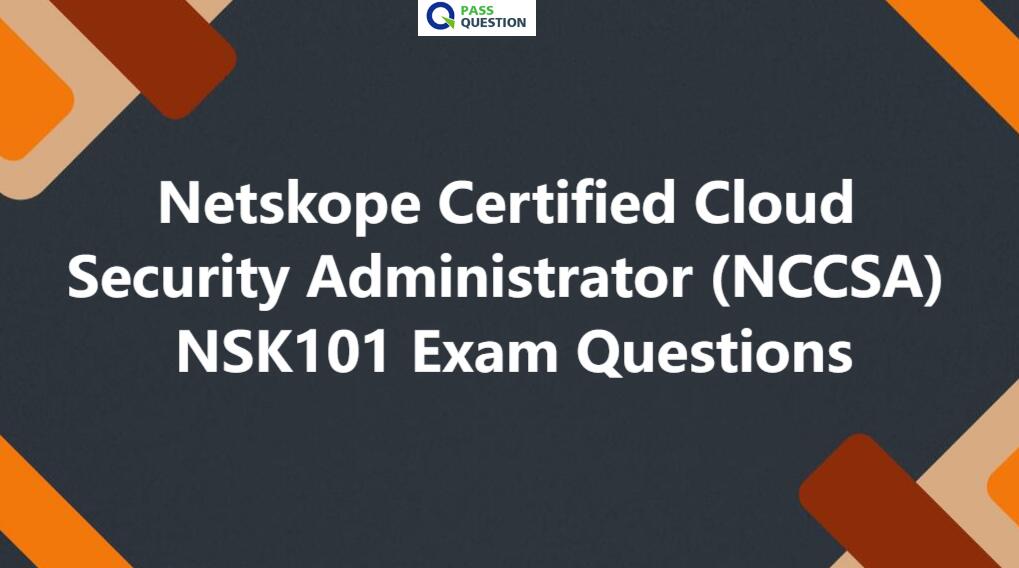Are you preparing for the Netskope Certified Cloud Security Administrator (NCCSA) NSK101 Exam? PassQuestion is here to assist you by providing the latest and most comprehensive Netskope Certified Cloud Security Administrator (NCCSA) NSK101 Exam Questions. These questions are meticulously prepared to cover all the key areas outlined in the NSK101 Certification syllabus, ensuring you completely understand all the necessary concepts. By utilizing the Netskope Certified Cloud Security Administrator (NCCSA) NSK101 Exam Questions, you can significantly increase your chances of success in the Netskope Certification exam on your first attempt.

Netskope Certified Cloud Security Administrator (NCCSA) – NSK101 Exam
Netskope Certified Cloud Security Administrator is awarded to cloud security practitioners who have completed a 90-minute exam proctored through Pearson VUE, the global expert in test delivery services. This exam and certification award replaces the former Netskope Cloud Security Administrator accreditation. Netskope Certified Cloud Security Administrator recognition is valid for two years from the award date. The validation is based on the actual date the exam is completed through Pearson VUE.
The Netskope Certified Cloud Security Administrator exam is based on the following industry practitioner profile:
The candidate understands cloud security concepts and the Netskope platform. They can configure, monitor, and perform basic troubleshooting, as required. Successful candidates will have approximately six months of practical experience on the Netskope Security Cloud platform, although no requirement is placed on this criterion.
Exam Topics
This exam focuses on the following topics:
Cloud Security Concepts
– Cloud security theory
– Common industry compliance standards
– Common cloud service model concepts
– Data-in-motion protection compared to data-atrest concepts
– Web security concepts
– Traffic steering concepts
Netskope Platform Concepts Basics
– Deployment modes
– Features and architectural benefits
– Security controls
– Cloud security risk management/reduction
Netskope Platform Management
– Steering traffic to Netskope
– Basic configuration elements
– Real-time inline or API policy configuration concepts
– Basic administration tasks
Netskope Platform Monitoring
– Identifying cloud risk using the Cloud Confidence Index (CCI)
– Event monitoring
Netskope Platform Troubleshooting
– Common steering issues
– Policy-related misconfigurations
– TLS decryption-related issues
– Collect log files used for service requests
View Online Netskope Certified Cloud Security Administrator (NCCSA) NSK101 Free Questions
1. What are two primary advantages of Netskope’s Secure Access Service Edge (SASE) architecture? (Choose two)
A. no on-premises hardware required for policy enforcement
B. Bayesian spam filtering
C. Endpoint Detection and Response (EDR)
D. single management console
Answer: A, D
2. Which two common security frameworks are used today to assess and validate a vendor’s security practices? (Choose two.)
A. Data Science Council of America
B. Building Security in Maturity Model
C. ISO 27001
D. NIST Cybersecurity Framework
Answer: B, C
3. What are two use cases for Netskope’s DLP solution? (Choose two.)
A. to stop unintentional data movement
B. to detect malware in files before they are uploaded to a cloud application
C. to detect sensitive data in password protected files
D. to ensure regulatory compliance
Answer: A, D
4. What are two uses for deploying a Netskope Virtual Appliance? (Choose two.)
A. as an endpoint for Netskope Private Access (NPA)
B. as a local reverse-proxy to secure a SaaS application
C. as a log parser to discover in-use cloud applications
D. as a Secure Forwarder to steer traffic
Answer: A, D
5. You need to block all users from uploading data files into risky collaboration applications.
Which element must you configure within Netskope’s CASB to accomplish this task?
A. DLP Rule
B. real-time policy
C. DLP Profile
D. block notification
Answer: B
6. What are two characteristics of Netskope’s Private Access Solution? (Choose two.)
A. It provides protection for private applications.
B. It provides access to private applications.
C. It acts as a cloud-based firewall.
D. It requires on-premises hardware.
Answer: AB
7. Your company asks you to obtain a detailed list of all events from the last 24 hours for a specific user.
In this scenario, what are two methods to accomplish this task? (Choose two.)
A. Use the Netskope reporting engine.
B. Export the data from Skope IT Application Events.
C. Use the Netskope REST API.
D. Export the data from Skope IT Alerts.
Answer: BC
8. Which two traffic steering configurations are supported by Netskope? (Choose two.)
A. browser isolation traffic only
B. cloud applications only
C. all Web traffic including cloud applications
D. Web traffic only
Answer: B, C
9. A customer wants to detect misconfigurations in their AWS cloud instances.
In this scenario, which Netskope feature would you recommend to the customer?
A. Netskope Secure Web Gateway (SWG)
B. Netskope Cloud Security Posture Management (CSPM)
C. Netskope Advanced DLP and Threat Protection
D. Netskope SaaS Security Posture Management (SSPM)
Answer: B
10. You want to set up a Netskope API connection to Box.
What two actions must be completed to enable this connection? (Choose two.)
A. Install the Box desktop sync client.
B. Authorize the Netskope application in Box.
C. Integrate Box with the corporate IdP.
D. Configure Box in SaaS API Data protection.
Answer: BD